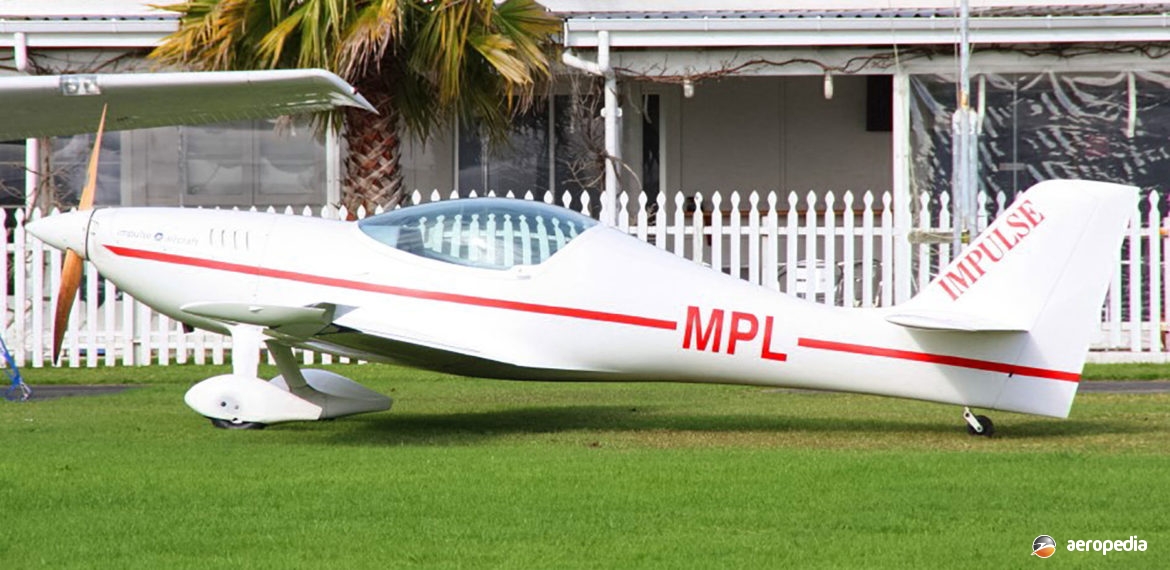Photograph:
Impulse Aircraft Impulse ZK-MPL (c/n NZ100UTK8J) in 2011 at Ardmore, NZ (NZCIVAIR)
Country of origin:
Germany
Description:
Two-seat light sport and training monoplane
Power Plant:
One 90 kw (120 hp) Jabiru 3300 six-cylinder horizontally-opposed air-cooled engine
Specifications:
- Wingspan: 7.92 m (26 ft)
- Length: 5.63 m (18 ft 6 in)
- Height: 1.55 m (5 ft 1 in)
- Wing area: 7.24 m² (78 sq ft)
- Max speed: 259 km/h (161 mph)
- Cruising speed at 75% power: 245 km/h (152 mph)
- Stalling speed: 66 km/h (41 mph)
- Speed at best rate of climb: 148 km/h (92 mph)
- Rate of climb: 488 m/min (1,600 ft/min)
- Max altitude: 5,486 m (18,000 ft)
- Empty weight: 290 kg (639 lb)
- Loaded weight: 472 kg (1,041 lb)
- Baggage capacity: 20 kg (44 kg)
History:
The Impulse was a high-performance German_designed light aircraft aimed at the ultralight market but which could be completed to meet general aviation regulations. Designed by Philipp Steinbach, it was the result of three years of development. The Impulse 100 underwent 1,600 hours of rigorous testing of the prototype and the manufacturer marketed it as having a maximum manoeuvring speed of 220 km/h (137 mph) and being tested to safe load factors of +5.6G/-5.6G. It was made available in kit form or as a built-up kit, kits being supplied by Impulse Aircraft Corporation of Rheinmunster, Germany.
The wing was of laminar flow cross-section producing a lift coefficient of 3.2 with the Fowler flaps extending to 30 degrees when fully down. The structure was of carbon-honeycomb sandwich with one box-type main spar. Integral wing fuel tanks provided a maximum capacity of 100 litres (22 Imp gals) in each wing. The wing consisted of two halves, the wings being connected to the fuselage via two main bolts on the main spar and a quick disconnect bolt on the rear spar, which carried the torsional loads.
The stabiliser and all control surfaces were also constructed of carbon-honeycomb sandwich, the fin being made of E-glass which enabled the antennas to be installed within the fin. The fuselage was built of carbon-honeycomb sandwich and the engine mount was a WIG welded steel framework of chrome-moly steel. The centre spar box, to which the two wing main spars were connected, was under the pilot’s knees.
The main bulkhead took the wing torsional loads and served as the backrest. The shoulder strips were attached on the first upper frame. The undercarriage legs were of aluminium and connected to the fuselage via the engine mount. The tailwheel was coupled via springs to the rudder. It had a 12-volt starter, electric Fowler flaps and hydraulic disc brakes.
The engine usually installed was the Australian-designed and built 90 kw (120 hp) [3300-cc] Jabiru six-cylinder unit, but other units could be installed by the builder, including the Jabiru 2200, Rotax 912 and 914, Lycoming 360, Thielert diesel, and the WAM 120 diesel. It could be used in the aerobatic role. The Allison 430 turboprop could be installed, one such aircraft being I-B648 in Italy which climbed at 250 km/h (155 mph) at 975 m/min (3,200 ft/min) and cruised at 426 km/h (265 mph).
In late 2003 Impulse Aircraft of New Zealand announced it was importing the type to this region, describing it as an outstanding microlight for the discerning pilot, approved in New Zealand at 544 kg (1,199 lb), “cruising at 135 knots on a meagre 22 litres per hour”. The first three aircraft in New Zealand were the 100TD model and were registered in January 2004, becoming ZK-LMG (c/n NZ100UTK7J), ZK-MGT (c/n NZ100UTK9J) and ZK-MPL (c/n NZ100UTK8J).

